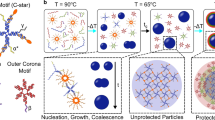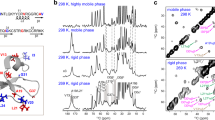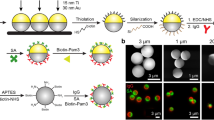Abstract
Double-stranded DNA (dsDNA) can trigger the production of type I interferon (IFN) in plasmacytoid dendritic cells (pDCs) by binding to endosomal Toll-like receptor-9 (TLR9; refs 1, 2, 3, 4, 5). It is also known that the formation of DNA–antimicrobial peptide complexes can lead to autoimmune diseases via amplification of pDC activation1,2. Here, by combining X-ray scattering, computer simulations, microscopy and measurements of pDC IFN production, we demonstrate that a broad range of antimicrobial peptides and other cationic molecules cause similar effects, and elucidate the criteria for amplification. TLR9 activation depends on both the inter-DNA spacing and the multiplicity of parallel DNA ligands in the self-assembled liquid-crystalline complex. Complexes with a grill-like arrangement of DNA at the optimum spacing can interlock with multiple TLR9 like a zipper, leading to multivalent electrostatic interactions that drastically amplify binding and thereby the immune response. Our results suggest that TLR9 activation and thus TLR9-mediated immune responses can be modulated deterministically.
This is a preview of subscription content, access via your institution
Access options
Subscribe to this journal
Receive 12 print issues and online access
$259.00 per year
only $21.58 per issue
Buy this article
- Purchase on Springer Link
- Instant access to full article PDF
Prices may be subject to local taxes which are calculated during checkout




Similar content being viewed by others
References
Lande, R. et al. Plasmacytoid dendritic cells sense self-DNA coupled with antimicrobial peptide. Nature 449, 564–569 (2007).
Lande, R. et al. Neutrophils activate plasmacytoid dendritic cells by releasing self-DNA–peptide complexes in systemic lupus erythematosus. Sci. Transl. Med. 3, 73ra19 (2011).
Hemmi, H. et al. A Toll-like receptor recognizes bacterial DNA. Nature 408, 740–745 (2000).
Haas, T. et al. The DNA sugar backbone 2′ deoxyribose determines Toll-like receptor 9 activation. Immunity 28, 315–323 (2008).
Barbalat, R., Ewald, S. E., Mouchess, M. L. & Barton, G. M. Nucleic acid recognition by the innate immune system. Annu. Rev. Immunol. 29, 185–214 (2011).
Tewary, P. et al. β-Defensin 2 and 3 promote the uptake of self or CpG DNA, enhance IFN-α production by human plasmacytoid dendritic cells, and promote inflammation. J. Immunol. 191, 865–874 (2013).
Li, Y., Berke, I. C. & Modis, Y. DNA binding to proteolytically activated TLR9 is sequence-independent and enhanced by DNA curvature. EMBO J. 31, 919–931 (2012).
Tian, J. et al. Toll-like receptor 9-dependent activation by DNA-containing immune complexes is mediated by HMGB1 and RAGE. Nature Immunol. 8, 487–496 (2007).
Yanai, H. et al. HMGB proteins function as universal sentinels for nucleic-acid-mediated innate immune responses. Nature 462, 99–103 (2009).
Gilliet, M. & Lande, R. Antimicrobial peptides and self-DNA in autoimmune skin inflammation. Curr. Opin. Immunol. 20, 401–407 (2008).
Martinez-Veracoechea, F. J. & Frenkel, D. Designing super selectivity in multivalent nano-particle binding. Proc. Natl Acad. Sci. USA 108, 10963–10968 (2011).
Brooks, H., Lebleu, B. & Vivès, E. Tat peptide-mediated cellular delivery: Back to basics. Adv. Drug Deliv. Rev. 57, 559–577 (2005).
Evans, H. M. et al. Structural polymorphism of DNA-dendrimer complexes. Phys. Rev. Lett. 91, 075501 (2003).
DeRouchey, J., Netz, R. & Rädler, J. Structural investigations of DNA-polycation complexes. Eur. Phys. J. E 16, 17–28 (2005).
Choe, J., Kelker, M. S. & Wilson, I. A. Crystal structure of human Toll-like receptor 3 (TLR3) ectodomain. Science 309, 581–585 (2005).
Liu, L. et al. Structural basis of Toll-like receptor 3 signaling with double-stranded RNA. Science 320, 379–381 (2008).
Kang, J. Y. & Lee, J-O. Structural biology of the Toll-like receptor family. Annu. Rev. Biochem. 80, 917–941 (2011).
Geerts, N. & Eiser, E. DNA-functionalized colloids: Physical properties and applications. Soft Matter 6, 4647–4660 (2010).
Luo, J. et al. Lateral clustering of TLR3: dsRNA signaling units revealed by TLR3ecd: 3Fabs quaternary structure. J. Mol. Biol. 421, 112–124 (2012).
Honda, K. et al. Spatiotemporal regulation of MyD88–IRF-7 signalling for robust type-I interferon induction. Nature 434, 1035–1040 (2005).
Koltover, I., Salditt, T., Rädler, J. O. & Safinya, C. R. An inverted hexagonal phase of cationic liposome-DNA complexes related to DNA release and delivery. Science 281, 78–81 (1998).
Rädler, J. O., Koltover, I., Salditt, T. & Safinya, C. R. Structure of DNA-cationic liposome complexes: DNA intercalation in multilamellar membranes in distinct interhelical packing regimes. Science 275, 810–814 (1997).
Sanders, L. K. et al. Control of electrostatic interactions between F-actin and genetically modified lysozyme in aqueous media. Proc. Natl Acad. Sci. USA 104, 15994–15999 (2007).
Wong, G. C. & Pollack, L. Electrostatics of strongly charged biological polymers: Ion-mediated interactions and self-organization in nucleic acids and proteins. Annu. Rev. Phys. Chem. 61, 171–189 (2010).
Acknowledgements
This work is supported by NSF grants DMR1411329 and DMR1106106, EU grants ARG-ERC-COLSTRUCTION 227758 and ITN-COMPLOIDS 234810, by the Herchel Smith Fund, and by the Slovenian Research Agency through Grant P1-0055, and the Swiss National Science Foundation (FN 310030-144072). X-ray research was conducted at Stanford Synchrotron Radiation Lightsource, SLAC National Laboratory, supported by the US DOE Office of Basic Energy Sciences under Contract No. DE-AC02-76SF00515, the Advanced Light Source, supported by the US DOE Office of Basic Energy Sciences under Contract No. DE-AC02-05CH11231, and at the UCLA CNSI.
Author information
Authors and Affiliations
Contributions
G.C.L.W., M.G., F.J. and N.W.S. conceived the project. R.L. and L.F. performed the cell experiments. F.J., N.W.S., W.X. and C.L. performed SAXS experiments. N.W.S., F.J. and C.L. analysed SAXS data. T.C., J.D. and D.F. conceived the computational model. T.C. performed simulations. G.C.L.W., N.W.S., M.G., D.F., J.D. and T.C. wrote the manuscript. F.J. and R.L. assisted with the methods section.
Corresponding authors
Ethics declarations
Competing interests
The authors declare no competing financial interests.
Supplementary information
Supplementary Information
Supplementary Information (PDF 2052 kb)
Rights and permissions
About this article
Cite this article
Schmidt, N., Jin, F., Lande, R. et al. Liquid-crystalline ordering of antimicrobial peptide–DNA complexes controls TLR9 activation. Nature Mater 14, 696–700 (2015). https://doi.org/10.1038/nmat4298
Received:
Accepted:
Published:
Issue Date:
DOI: https://doi.org/10.1038/nmat4298
This article is cited by
-
Molecular engineering of antimicrobial peptides: microbial targets, peptide motifs and translation opportunities
Biophysical Reviews (2021)
-
Neutrophil extracellular trap-associated RNA and LL37 enable self-amplifying inflammation in psoriasis
Nature Communications (2020)
-
The commensal skin microbiota triggers type I IFN–dependent innate repair responses in injured skin
Nature Immunology (2020)
-
CXCL4 assembles DNA into liquid crystalline complexes to amplify TLR9-mediated interferon-α production in systemic sclerosis
Nature Communications (2019)
-
Helical antimicrobial peptides assemble into protofibril scaffolds that present ordered dsDNA to TLR9
Nature Communications (2019)



